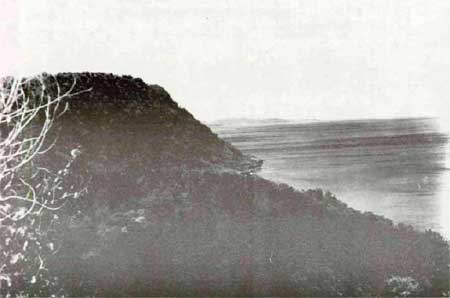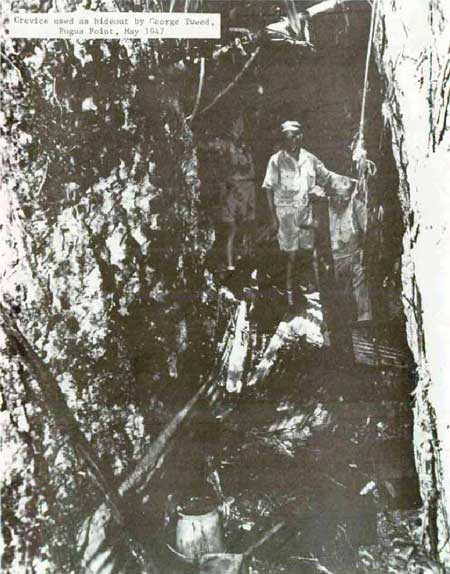|
War in the Pacific
Historic Resource Study |

|
F. Other Significant World War II Sites on Guam
II. Tweed's Cave
When the Japanese captured Guam in December 1941, six U.. 5. Navy men escaped into the jungle. Four were from the Radio Communications Center, Agana: Radiomen First Class Al Tyson and George Ray Tweed, Yeoman First Class A. Yablonsky, and Chief Aerographer L.W. Jones. The other two were crew members of USS Penguin a patrol craft that the Japanese had sunk on December 8: Chief Machinist Mate L. L. Krump and Machinist Mate First Class C.B. Johnston.
George Tweed had served in the Navy for 16 years. Just a few weeks earlier his wife and son had been evacuated from Guam along with other navy families. When the Japanese landed on December 10, Tweed jumped in his ancient car. He picked up Tyson on the road. The two drove about eleven miles southeast of Agana and hid the car in the jungle. They first hid in the Yona area on Guam's east coast. The other four men hid nearby in the Manengon area on the Ylig River, where later the Japanese concentrated Guamanians. Then, the six men stayed together for several weeks before deciding to divide into parties of two. The Japanese soon became aware of the men and issued orders that they surrender in 30 days or be beheaded. None surrendered.
In February 1942, Tweed and his partner split and Tweed was on his own. Jones, Yabonsky, and Krump were the first to be captured. Around July 1942 they were bayonetted and beheaded by the Japanese. Tyson and Johnston hid in the Oka Point area for six months where Father Jesus Duenas visited them once every four weeks. In October, the Japanese discovered and shot the two men. Tweed, expecting the arrival of the U. S. Navy at any time, was now on his own. It was later estimated that about 50 Guamanians aided the Americans throughout 1942.
During 1942 and early 1943, Tweed kept on the move, always aided by his Chamorro friends. By the end of 1942 he was hiding twelve miles north of Agana. He then moved to the rugged cliffs at Pugua Point where he built a shelter in an isolated crevice atop a huge rock formation. Here he continued to receive assistance from sympathetic Guamanians, at great danger to themselves. Eventually, some Chamorros, including Father Duenas, were executed for their suspected loyalty to the American sailor.
On July 10, 1944, Tweed succeeded in attracting the attention of two U.S. destroyers by signaling with homemade flags and a mirror. He was rescued, flown to the United States, and reunited with his family. Some Guamanians thought he should have surrendered long ago to prevent their people from being tortured. In the United States, Tweed was a hero. [16]
The Pugua Point area is federal property and is administered by the U.S. Navy.

|
| George Tweed's hideout, Pugua Point, May 1947. |

|
| Crevice used as hideout by George Tweed, Pugua Point, May 1947. |
| <<< Previous | <<< Contents >>> | Next >>> |
wapa/hrs/hrsf1.htm
Last Updated: 07-Mar-2005